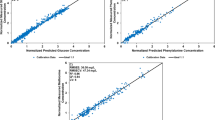Abstract
The maximization of biomass productivity in fed-batch cultures of hybridoma cells is analyzed based on the overflow metabolism model. Due to overflow metabolism, often attributed to limited oxygen capacity, lactate and ammonia are formed when the substrate concentrations (glucose and glutamine) are above a critical value, which results in a decrease in biomass productivity. Optimal feeding rate, on the one hand, for a single feed stream containing both glucose and glutamine and, on the other hand, for two separate feed streams of glucose and glutamine are determined using a Nelder–Mead simplex optimization algorithm. The optimal multi exponential feed rate trajectory improves the biomass productivity by 10 % as compared to the optimal single exponential feed rate. Moreover, this result is validated by the one obtained with the analytical approach in which glucose and glutamine are fed to the culture so as to control the hybridoma cells at the critical metabolic state, which allows maximizing the biomass productivity. The robustness analysis of optimal feeding profiles obtained with different optimization strategies is considered, first, with respect to parameter uncertainties and, finally, to model structure errors.













Similar content being viewed by others
References
Rodrigues ME, Costa AR, Henriques M, Azeredo J, Oliveira R (2010) Technological progresses in monoclonal antibody production systems. Biotechnol Prog 26:332–351
Reichert JC, Rosensweig CJ, Faden LB, Dewitz MC (2005) Monoclonal antibody successes in the clinic. Nat Biotechnol 23:1073–1078
Wurm FM (2004) Production of recombinant protein therapeutics in cultivated mammalian cells. Nat Biotechnol 22:1393–1398
Sheikholeslami Z, Jolicoeur M, Henry O (2013) The impact of the timing of induction on the metabolism and productivity of CHO cells in culture. Biochem Eng J 79:162–171
Bibila TA, Robinson DK (1995) In pursuit of the optimal fed-batch process for monoclonal antibody production. Biotechnol Prog 11:1–13
Wong DCF, Wong KTK, Goh LT, Heng CK, Yap MGS (2005) Impact of dynamic online fed-batch strategies on metabolism, productivity and N-glycosylation quality in CHO cell cultures. Biotechnol Bioeng 89(2):164–177
Jianqiang L, Mutsumi T, Yinbo Q, Toshiomi Y (2002) Possible strategy for on line monitoring and control of hybridoma cell culture. Biochem Eng J 11:205–209
de Tremblay M, Perrier M, Chavarie C, Archambault J (1992) Optimization of fed-batch culture of hybridoma cells using dynamic programming: single and multi feed cases. Bioproc Eng 7:229–234
Dhir S, Morrow KJ, Rhinehart RR, Wiesner T (2000) Dynamic optimization of hybridoma growth in a fed-batch bioreactor. Biotechnol Bioeng 67(2):197–205
Nguang SK, Chen L, Chen XD (2001) Optimisation of fed-batch culture of hybridoma cells using genetic algorithms. ISA Trans 40:381–389
Sonnleitner B, Käppeli O (1986) Growth of Saccharomyces cerevisiae is controlled by its limited respiratory capacity: formulation and verification of a hypothesis. Biotechnol Bioeng 28:927–937
Niu H, Daukandt M, Rodriguez C, Fickers P, Bogaerts Ph (2013) Dynamic modeling of methylotrophic Pichia pastoris culture with exhaust gas analysis: from cellular metabolism to process simulation. Chem Eng Sci 87:381–392
Xu B, Jahic M, Enfors SO (1999) Modeling of overflow metabolism in batch and fed batch cultures of Escherichia coli. Biotechnol Progr 15:81–90
Doverskog M, Ljunggren J, Öhman L, Häggström L (1997) Physiology of cultured animal cells. J Biotechnol 59:103–115
Diaz-Ruiz R, Uribe Carvajal S, Devin A, Rigoulet M (2009) Tumor cell energy metabolism and its common features with yeast metabolism. Biochim Biophys Acta 1796:252–265
Valentinotti S, Srinivasan B, Holmberg U, Bonvin D, Cannizzaro C, Rhiel M, von Stockar U (2003) Optimal operation of fed-batch fermentations via adaptive control of overflow metabolite. Cont Eng Pract 11:665–674
Dewasme L, Richelle A, Dehottay P, Georges P, Remy M, Bogaerts Ph, Vande Wouwer A (2010) Linear robust control of S. cerevisiae fed-batch cultures at different scales. Biochem Eng J 53:26–37
Santos L, Dewasme L, Coutinho D, Vande Wouwer A (2012) Nonlinear model predictive control of fed-batch cultures of micro-organisms exhibiting overflow metabolism: assessment and robustness. Comput Chem Eng 39:143–151
Amribt Z, Niu H, Bogaerts Ph (2013) Macroscopic modelling of overflow metabolism and model based optimization of hybridoma cell fed-batch cultures. Biochem Eng J 70:196–209
Selvarasu S, Wong V, Karimi I, Lee D-Y (2008) Elucidation of metabolism in hybridoma cells grown in fed-batch culture by genome-scale modeling. Biotechnol Bioeng 102(5):1494–1504
Ozturk SS, Riley MR, Palsson BO (1991) Effects of ammonia and lactate on hybridoma growth, metabolism and antibody production. Biotechnol Bioeng 39:418–431
Dewasme L, Amribt Z, Santos L, Hantson AL, Bogaerts Ph, Vande Wouwer A (2013) Hybridoma cell culture optimization using nonlinear model predictive control. In: Proceedings of the 12th IFAC Symposium on Computer Applications in Biotechnology in Mumbai, pp 72–77
Acknowledgments
Work has been supported by FEDER (European Union and Wallonia Region) in the Hainaut-Biomed program (OCPAM project). This paper presents research results of the Belgian Network DYSCO (Dynamical Systems, Control, and Optimization) funded by the Interuniversity Attraction Poles Programme, initiated by the Belgian State, Science Policy Office. The scientific responsibility rests with its authors.
Author information
Authors and Affiliations
Corresponding author
Rights and permissions
About this article
Cite this article
Amribt, Z., Dewasme, L., Vande Wouwer, A. et al. Optimization and robustness analysis of hybridoma cell fed-batch cultures using the overflow metabolism model. Bioprocess Biosyst Eng 37, 1637–1652 (2014). https://doi.org/10.1007/s00449-014-1136-2
Received:
Accepted:
Published:
Issue Date:
DOI: https://doi.org/10.1007/s00449-014-1136-2




